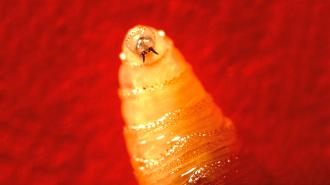Uruguay is developing a CRISPR gene drive to eradicate the New World screwworm, a parasitic fly that kills cattle in a painful, grisly fashion. Releasing it into the wild would have risks, but if it works, it could help rid South America of this horrific agricultural pest.
Nightmare fuel: The screwworm fly lays its eggs on living creatures — often livestock — and once they hatch, the larvae eat into the animal’s flesh for about a week, before emerging from the tunnel they created and flying away.
“We know that it’s horrendously painful, because people get affected by this, and the standard of treatment is you give them morphine immediately so that surgeons can cut the things out — because it’s just that painful; it’s unbelievably agonizing,” Kevin Esvelt, a biologist at the MIT Media Lab, told the 80,000 Hours podcast in 2023.
Aside from being painful, screwworm infestations of livestock are incredibly costly. In the 1950s, the US meat and dairy industries were losing an estimated $200 million per year to the pests — that’d be about $2.3 billion today.
Irradiation nation: Screwworms are no longer a problem for American farmers thanks to the USDA. In 1955, it set out to eradicate the screwworm in the US by irradiating the insects’ larvae, which made adults sterile. Infertile males could then be released into infested areas to mate with females, which wouldn’t produce any offspring.
The USDA then helped Mexico and the rest of Central America get rid of the pests in the same way. Today, it collaborates with Panama to raise and release millions of sterile screwworm flies every week, creating a “moat” of infertile flies between North and South America.
What’s new? There are too many screwworms in South America to control through irradiated insect releases, so researchers are looking for alternatives to clear the continent of the insects — and that’s led them to gene drives.
Normally, an animal has a 50/50 chance of passing any gene onto its offspring. A gene drive is a phenomenon that dramatically betters these odds. They’re found in nature, and Esvelt led a team that figured out how to create them using CRISPR.
“Uruguay loses about 0.1% of their total country’s GDP to the screwworm.”
Kevin Esvelt
Esvelt is now working with officials in Uruguay on a project to create a gene drive in non-sterile male screwworms. The drive would be paired with a gene that renders only female offspring sterile. The male offspring, meanwhile, would be able to mate, spreading the gene to more generations, cutting the number of fertile females until eventually the population collapses.
“Uruguay loses about 0.1% of their total country’s GDP to the screwworm because they’re so dependent on animal exports … they’re all very concerned about their beef, and screwworm is horrific,” said Esvelt.
The cold water: Gene drives are risky business. Once released into the wild, there’s no proven way to stop them from permanently altering a species, and it’s possible the edited insects might have some unintended negative impact on the ecosystem.
Researchers are looking for ways to create “brakes” for gene drives, though. Ideas include drives that only persist for a set number of generations or releasing specially bred insects that would inactivate the gene drive if they mated with an insect carrying it.
Looking ahead: It’ll likely take many years of lab testing before any edited screwworms are released into the wild in Uruguay, but Esvelt is hopeful the gene drive will be a gamechanger in the battle against these horrific pests in South America.
“This would be a project run effectively by Uruguayans, for the benefit of Uruguay, and may be offered eventually — if it works well— to a broader array of folks throughout South America,” he told MIT Technology Review.
We’d love to hear from you! If you have a comment about this article or if you have a tip for a future Freethink story, please email us at tips@freethink.com.
